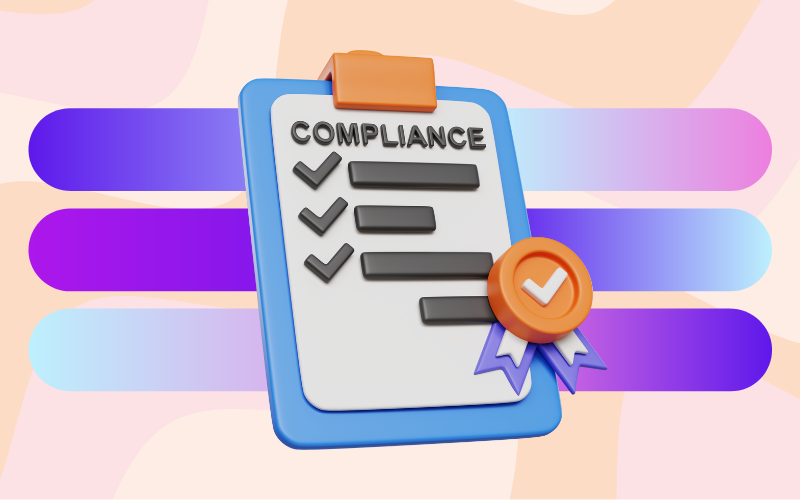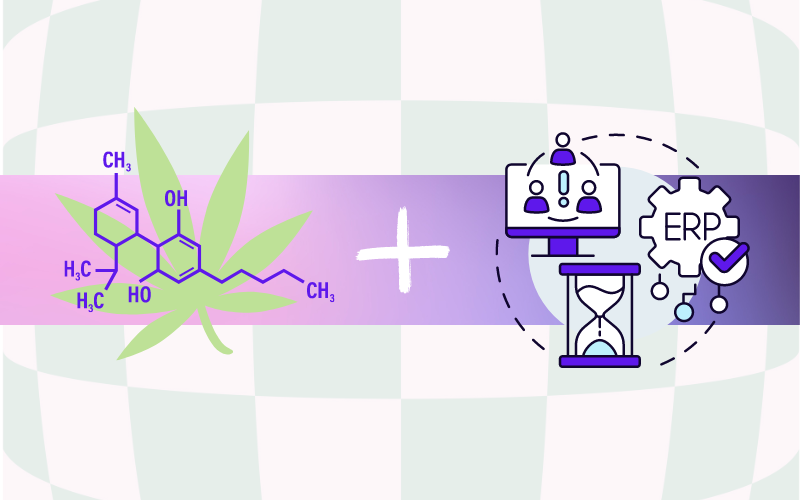What is Cannabis ERP Software
Cannabis ERP software is a comprehensive solution tailored to the unique needs of the cannabis industry, integrating and managing various business functions such as:
- Inventory Management: Tracks cannabis products, including raw materials, intermediate goods, and finished products.
- Seed-to-Sale Tracking: Ensures complete traceability of products from cultivation to distribution, meeting regulatory requirements.
- Compliance Reporting: Generates reports for regulatory obligations, including license tracking, tax reporting, and compliance audits.
- Financial Management: Manages financial transactions, budgeting, invoicing, accounts payable/receivable, and financial reporting.
- Quality Control: Monitors and manages product quality, including testing and compliance with standards.
- Customer Relationship Management (CRM): Tracks customer information, sales data, and marketing campaigns to improve satisfaction and retention.
Cannabis ERP software serves as a centralized platform to streamline operations, improve efficiency, and maintain compliance. By providing a holistic view of the entire supply chain—from cultivation and manufacturing to distribution and retail—it enables better control over processes and informed decision-making.
This integration reduces manual errors, enhances productivity, and ensures compliance, providing a solid foundation for businesses to thrive in a competitive market.

Why Cannabis Businesses Need ERP Software
ERP systems are essential for cannabis businesses due to strict federal and state regulations in legal markets. Failure to properly account for cannabis products and finances can result in steep penalties or even business closure.
Cannabis operators who invest in ERP systems can become part of a rapidly growing industry. The Cannabis ERP Software Market, valued at USD 318.21 million in 2023, is projected to reach USD 1.2 billion by 2030 within states where cannabis is legal.

This revenue could potentially be much higher if cannabis is legalized nationwide. Simply put, avoiding a cannabis ERP solution not only means leaving significant revenue on the table but also risking legal jeopardy with federal and state regulators.
What Are The Benefits of Cannabis ERP
ERP in general offers a variety of benefits for businesses of any size but when it comes to the cannabis industry, cannabis business owners need one critical component to stay legally operational and that is compliance. Below are the main benefits of a Cannabis ERP solution from maintaining compliance to streamlining workflows:
- Enhanced Traceability and Quality Control: Cannabis ERP software offers robust traceability, tracking products from seed to sale. It logs every stage, ensuring compliance with state and federal regulations, and helps quickly address quality issues or recalls. This builds trust with dispensaries and consumers by demonstrating a commitment to quality.
- Improved Financial Management and Cost Tracking: Efficient financial management is crucial for long-term success. Cannabis ERP software automates financial processes, providing real-time visibility into financial health. It tracks expenses, manages budgets, and generates detailed financial reports, enabling informed decision-making and cost optimization.
- Streamlined Seed-to-Sale Processes: ERP software integrates the entire seed-to-sale process, managing inventory levels, tracking product movement, and optimizing production schedules. This reduces manual errors, enhances productivity, and ensures a seamless product flow, meeting customer demands effectively.
- Regulatory Compliance and Reporting: Compliance is a top priority for cannabis businesses. ERP software automates reporting and ensures adherence to regulations, generating accurate reports and tracking licenses and permits. This minimizes non-compliance risks, avoids penalties, and maintains licenses.https://www.findlaw.com/cannabis-law/cannabis-laws-and-regulations.html
- Scalability and Growth Potential: As the industry evolves, businesses need to scale operations. Cannabis ERP software supports scalability, accommodating new cultivation sites, multiple locations, and new product lines. This ensures efficient growth without compromising compliance, positioning businesses for long-term success.
Implementing cannabis ERP not only reduces overhead and improves daily operations but, most importantly, ensures compliance with federal and state regulations. It is crucial for both new and established cannabis businesses to perform due diligence regarding these laws.
How to Choose the Right Cannabis ERP Solution for Your Business
Selecting the right cannabis ERP solution is a critical decision that can significantly impact the success and growth of your cannabis business. Here are some key considerations to guide you in choosing the ideal cannabis ERP solution:
1. Consider All Aspects of Your Business
Before selecting a cannabis ERP solution, assess the specific needs and requirements of your business. Consider factors such as the size of your cultivation operation, the complexity of your supply chain, the number of dispensary locations, and the specific regulatory requirements in your state.
For instance, if you operate both a cultivation site and multiple retail locations, you’ll need a solution that can seamlessly integrate operations across all sites. Understanding your business’s unique characteristics will help you identify the features and functionalities essential for your ERP solution.
2. Define Business Requirements
Clearly define your business requirements and objectives when evaluating cannabis ERP solutions. Identify the key functionalities you need, such as:
- Inventory Management: For tracking plant batches, harvested product, and inventory levels in dispensaries.
- Seed-to-Sale Tracking: To ensure compliance with regulations and maintain a complete product lifecycle history.
- Compliance Reporting: Automated reporting and Metrc integration to meet state and federal requirements.
- Financial Management: Tools for managing costs, revenue, and profitability across different product lines.
- Customer Relationship Management (CRM): To manage interactions with customers and loyalty programs at retail locations.
Consider any specific integrations you require with other software systems, like point-of-sale (POS) systems for dispensaries or accounting software. Having a clear understanding of your requirements will help you narrow down your options and find a solution that aligns with your business goals.
3. Evaluate User-Friendliness and Scalability
User-friendliness is a crucial factor when choosing a cannabis ERP solution. Look for a system that is intuitive, easy to navigate, and requires minimal training for your staff to use effectively. A user-friendly interface will enhance adoption and productivity within your organization.
Additionally, consider the scalability of the ERP solution. As your business grows, your software should be able to accommodate increased data volume, additional users, and expanded operations. For example, if you plan to expand from a single-state operation to a multi-state operator (MSO), ensure that the ERP solution can support this growth and manage the complexities of operating in different regulatory environments.
4. Assess Vendor Reputation and Support
Evaluate the reputation and track record of the ERP vendor. Research their experience in the cannabis industry and their understanding of the unique challenges and requirements specific to the industry. Look for customer reviews, case studies, and testimonials to gauge customer satisfaction.
Equally important is the level of support provided by the vendor. Ensure that they offer comprehensive customer support, including training and ongoing technical assistance. A reliable and responsive vendor will be instrumental in the successful implementation and utilization of your cannabis ERP solution. For instance, a vendor with a strong support team can assist with compliance updates as regulations evolve.
5. Consider Total Cost of Ownership (TCO)
Evaluate the total cost of ownership (TCO) of the cannabis ERP solution. Consider not only the upfront costs, such as licensing fees and implementation costs, but also ongoing expenses, such as maintenance, updates, and support fees. Assess the return on investment (ROI) potential and the long-term value that the ERP solution can bring to your business, ERP systems are noted for delivering significant ROI.
For instance, businesses report a 52% average ROI from ERP implementations, meaning that for every dollar invested, they see a return of $1.52. The payback period for these investments is typically between two to three years.
By considering these factors and conducting thorough research, you can choose the right cannabis ERP solution that aligns with your business goals, optimizes your operations, and ensures compliance with industry regulations.

Implementing Cannabis ERP
Implementing a cannabis ERP system is a significant undertaking that requires careful planning and execution. To ensure a successful implementation, follow these key steps:
1. Define Measurable Goals and KPIs
Before implementing a cannabis ERP system, establish clear and measurable goals for the project. Identify the key performance indicators (KPIs) that you will use to track the success of the implementation. These goals and KPIs will serve as benchmarks to measure the effectiveness of the ERP system and guide your implementation strategy.
2. Get Everyone on the Same Page
Ensure that all stakeholders within your organization are aligned and understand the purpose and benefits of implementing a cannabis ERP system. Conduct internal meetings and training sessions to educate employees about the new system and address any concerns or questions they may have. By getting everyone on the same page, you can foster a sense of ownership and enthusiasm for the ERP implementation.
3. Have a Plan
Develop a comprehensive implementation plan that outlines the steps and timeline for the ERP deployment. Determine the necessary resources, including personnel, hardware, and software requirements. Assign roles and responsibilities to key team members who will oversee the implementation process. A well-defined plan will help keep the project on track and ensure a smooth transition to the new system.
4. Establish an Internal Team
Create a dedicated internal team responsible for overseeing the implementation process. This team should consist of individuals from different departments who have a deep understanding of your business processes and can provide valuable insights. Assign a project manager to lead the team and coordinate efforts across different departments. Regular communication and collaboration within the team are vital for a successful implementation.
5. Do Not Do It Without a Partner
Consider partnering with an experienced cannabis ERP implementation partner or consultant. They can provide expertise, guidance, and support throughout the implementation process. A knowledgeable partner can assist with system configuration, data migration, user training, and offer valuable insights into industry best practices. Their support can significantly reduce implementation risks and ensure a successful and efficient deployment of your cannabis ERP system.
6. Test and Train
Before fully deploying the ERP system, conduct thorough testing to ensure its functionality and compatibility with your business processes. Test various scenarios and workflows to identify and resolve any issues or inefficiencies. Once testing is complete, provide comprehensive training to your employees to familiarize them with the system’s features and functionalities. Training should cover system navigation, data input, reporting, and any specific processes relevant to their roles.
7. Monitor and Evaluate
Monitor the performance and usage of the cannabis ERP system after the implementation. Continuously evaluate its effectiveness in meeting your goals and KPIs. Collect feedback from users and address any performance issues or areas for improvement. Regularly review and update processes and workflows to maximize the system’s potential and adapt to evolving business needs.
By following these implementation steps and leveraging the expertise of internal and external resources, you can successfully implement a cannabis ERP system and unlock its full potential to streamline operations, enhance compliance, and support the growth of your cannabis business.

How Much Does Cannabis ERP Software Cost?
The cost of cannabis ERP software can vary significantly based on several factors, including the size and complexity of your operations, the specific functionalities you require, and the vendor you choose. Here are some key cost components to consider:
- Licensing Fees: This is the upfront cost for accessing the software. It is usually a monthly subscription per user.
- Implementation Costs: These include expenses for software setup, customization, and integration with existing systems.
- Training and Support: Ongoing training for staff and support services to address technical issues.
- Maintenance and Updates: Regular updates and maintenance to ensure the software remains compliant with changing regulations and continues to meet business needs.
Typical Price Range
- Small to Medium Businesses: $5,000 to $50,000 per year.
- Large Enterprises: $50,000 to $500,000 per year or more, depending on the scale and complexity of the implementation.
Additional Factors
- Number of Users: More users typically increase the cost.
- Customization Needs: Highly customized solutions will cost more.
- Integration Requirements: Integrating with other systems, like POS or shipping software, can add to the cost.
For a detailed understanding of how much a cannabis ERP solution might cost for your specific needs, it’s best to contact us for a discovery call to determine what the best possible fit is for your unique business needs.

How Long Should Implementation Take?
The implementation of cannabis ERP software can vary widely based on the size of the operation, the complexity of the required customizations, and the readiness of the organization. Typically, a standard implementation can take anywhere from 3 to 6 months.
However, larger and more complex projects might extend up to 12 months or more. Key factors influencing the timeline include:
- Scope of Customization
- Integration with Existing Systems
- User Training and Onboarding
- Regulatory Compliance Requirements

Final Thoughts
Cannabis is here to stay and is rapidly expanding. Being first to market with streamlined operations and legal compliance could position your business as a leader in the cannabis industry, rather than playing catch-up.
Be proactive instead of reactive when it comes to such a fast paced industry. Schedule your free discovery call with Alchemy 365 to explore how we can be your ERP partner of choice for implementing your cannabis ERP solution.









